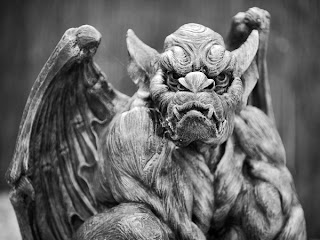The so-called “Great Wheel” of AD&D cosmology takes its lumps from folks who feel its non-mythic, too mechanical, and over-complicated. To these charges, I find the system guilty--but I’d add for the sake of fairness that one should look at its virtues. After a discussion of this nature over at
Dreams in the Lich House,
Beedo suggested I offer a counterargument here. I’ve touched on ways I feel the Great Wheel can be reconceptualized
before (
twice)--but I’ll summarize my argument in favor of it here, before diving into a slightly new way to look at it.
So, to it’s virtues:
1. It’s complicated: That’s right--this can be be both a deficit and an asset. The system of correspondences, associations, and the like in hermetic magic is a lot less streamlined than fire and forget or comic book-esque magic blasts, but its got a little thing called
verisimilitude.
Ptomelaic epicycles are complicated as hell (and terribly wrong) but they’re authentic. The Great Wheel, ironically, has some of this “almost too convoluted to make up” charm about it.
2. It’s consistent: The implied setting of AD&D has morality (i.e. alignment) as a tangible force with teams, and secret languages, and auras (or something) that can be identified by spells. It makes sense that the realms of gods, devils, and the afterlife would operate on this same system--as above, so below, as it were. In fact, any cosmology that
doesn’t take into account the reality of alignment in AD&D as written, is really an incomplete one, as there’s an odd, omnipresent force unaccounted for.
3. It’s weird: By this I mean its cobbled together (syncretic might be a better term) and idosyncratic. It’s strangely uniform in some ways, and oddly random in others. In other words, it reminds me of crackpot theories of physics, or theosophic ramblings, and whole swathes of occultism. Looking at that diagram in in 1E
Deities and Demigods is like hearing about the
Philadelphia Experiment, or reading an occult tome that claims to be the “real”
Necronomicon. It’s crazy, but the sort of crazy that makes one curious.
All well and good, you might say, but what do you do with it? This a complicated question. First off, I’d say take a look at it through these principles:
1.
The Outer Planes are representations of “human” ideas/concerns (the Anthropic Principle).
2.
The Outer Planes are not material places but conceptual ones: their appearance is malleable, and they're perhaps more symbolic than literal:
perhaps like being in a dream in
Inception, or maybe like Ditko’s surrealist portrayal of magical realms in
Doctor Strange comics.
3.
Each plane is sort of symbolic or representational of some aspect of its alignment: Hades might be the archetypal prison, for instance. Deities don't so much dwell there in the sense they someone might live in the suburbs, they dwell there in the sense that are associated with its archetypes or ethos. In this respect, they might resemble the sephiroth of
Qabalah as portrayed in hermeticism-- Alan Moore’s
Promethea being a great (and gameable) representation of this.
If this generates any sort of interest I might give some examples in a future post--or maybe I’ll give ‘em regardless, if I’m of a mind.





















































